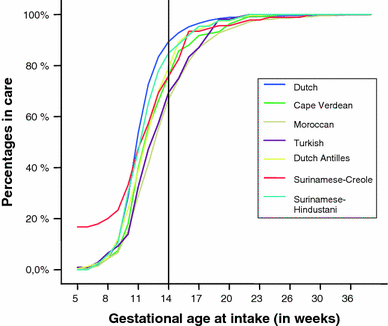Explaining ethnic differences in late antenatal care entry by predisposing, enabling and need factors in The Netherlands. The Generation R Study
- PMID: 20533083
- PMCID: PMC3131512
- DOI: 10.1007/s10995-010-0619-2
Explaining ethnic differences in late antenatal care entry by predisposing, enabling and need factors in The Netherlands. The Generation R Study
Abstract
Despite compulsory health insurance in Europe, ethnic differences in access to health care exist. The objective of this study is to investigate how ethnic differences between Dutch and non-Dutch women with respect to late entry into antenatal care provided by community midwifes can be explained by need, predisposing and enabling factors. Data were obtained from the Generation R Study. The Generation R Study is a multi-ethnic population-based prospective cohort study conducted in the city of Rotterdam. In total, 2,093 pregnant women with a Dutch, Moroccan, Turkish, Cape Verdean, Antillean, Surinamese Creole and Surinamese Hindustani background were included in this study. We examined whether ethnic differences in late antenatal care entry could be explained by need, predisposing and enabling factors. Subsequently, logistic regression analysis was used to assess the independent role of explanatory variables in the timing of antenatal care entry. The main outcome measure was late entry into antenatal care (gestational age at first visit after 14 weeks). With the exception of Surinamese-Hindustani women, the percentage of mothers entering antenatal care late was higher in all non-Dutch compared to Dutch mothers. We could explain differences between Turkish (OR = 0.95, CI: 0.57-1.58), Cape Verdean (OR = 1.65. CI: 0.96-2.82) and Dutch women. Other differences diminished but remained significant (Moroccan: OR = 1,74, CI: 1.07-2.85; Dutch Antillean OR 1.80, CI: 1.04-3.13). We found that non-Dutch mothers were more likely to enter antenatal care later than Dutch mothers. Because we are unable to explain fully the differences regarding Moroccan, Surinamese-Creole and Antillean women, future research should focus on differences between 1st and 2nd generation migrants, as well as on language barriers that may hinder access to adequate information about the Dutch obstetric system.
Figures
Similar articles
-
Ethnic differences in antenatal care use in a large multi-ethnic urban population in the Netherlands.Midwifery. 2011 Feb;27(1):36-41. doi: 10.1016/j.midw.2009.07.008. Epub 2009 Nov 25. Midwifery. 2011. PMID: 19939527
-
Ethnic disparities in maternal obesity and weight gain during pregnancy. The Generation R Study.Eur J Obstet Gynecol Reprod Biol. 2015 Oct;193:51-60. doi: 10.1016/j.ejogrb.2015.06.031. Epub 2015 Jul 8. Eur J Obstet Gynecol Reprod Biol. 2015. PMID: 26232727 Free PMC article.
-
Late start of antenatal care among ethnic minorities in a large cohort of pregnant women.BJOG. 2007 Oct;114(10):1232-9. doi: 10.1111/j.1471-0528.2007.01438.x. Epub 2007 Jul 26. BJOG. 2007. PMID: 17655734
-
Smoking during pregnancy in ethnic populations: the Generation R study.Nicotine Tob Res. 2008 Aug;10(8):1373-84. doi: 10.1080/14622200802238944. Nicotine Tob Res. 2008. PMID: 18686185
-
Ethnic disparities in general and abdominal adiposity at school age: a multiethnic population-based cohort study in the Netherlands.Ann Nutr Metab. 2014;64(3-4):208-17. doi: 10.1159/000365022. Epub 2014 Oct 2. Ann Nutr Metab. 2014. PMID: 25300262
Cited by
-
The magnitude and determinants of delayed initiation of antenatal care among pregnant women in Gambia; evidence from Gambia demographic and health survey data.BMC Public Health. 2023 Mar 30;23(1):599. doi: 10.1186/s12889-023-15506-0. BMC Public Health. 2023. PMID: 36997930 Free PMC article.
-
The Generation R Study: design and cohort update 2010.Eur J Epidemiol. 2010 Nov;25(11):823-41. doi: 10.1007/s10654-010-9516-7. Epub 2010 Oct 22. Eur J Epidemiol. 2010. PMID: 20967563 Free PMC article.
-
Exploring discrimination and racism in healthcare: a qualitative phenomenology study of Dutch persons with migration backgrounds.BMJ Open. 2024 Jun 4;14(6):e082481. doi: 10.1136/bmjopen-2023-082481. BMJ Open. 2024. PMID: 38834316 Free PMC article.
-
Prenatal care adequacy of migrants born in conflict-affected countries and country-born parturients in Finland.J Migr Health. 2022 May 31;6:100122. doi: 10.1016/j.jmh.2022.100122. eCollection 2022. J Migr Health. 2022. PMID: 35677660 Free PMC article.
-
Differences in timely antenatal care between first and second-generation migrants in the Netherlands.J Immigr Minor Health. 2014 Aug;16(4):631-7. doi: 10.1007/s10903-013-9841-5. J Immigr Minor Health. 2014. PMID: 23702785
References
Publication types
MeSH terms
LinkOut - more resources
Full Text Sources
Medical


